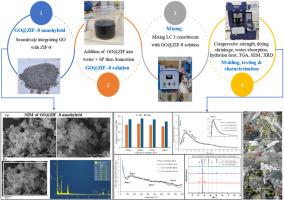Holistic effect of GO@ZIF-8 nanohybrids in LC3-based mortar
IF 4.7
3区 材料科学
Q2 MATERIALS SCIENCE, MULTIDISCIPLINARY
引用次数: 0
Abstract
Limestone calcined clay cement (LC3) offers a low-carbon alternative to Portland cement but has limitations, including drying shrinkage and reduced early compressive strength. This study explores nanohybrids to enhance LC3 mortar properties. A new hybrid of graphene oxide and zeolitic imidazolate framework-8 (GO@ZIF-8) was synthesized and added to LC3 mortar in varying dosages. Tests on hardened LC3 mortar measured improvements in compressive strength, drying shrinkage, water absorption, heat of hydration, and microstructure. Results showed 0.2 wt% GO@ZIF-8 increased compressive strength slightly by 2.9 % and reduced drying shrinkage by 9.1 %, though porosity rose by 6.67 %, and water absorption increased from 2.8 % (control) to 3.06 % and 3.20 % with 0.2 and 0.4 wt% GO@ZIF-8. Adding 0.3 wt% accelerated Phase II hydration, enhancing hydration products and crystallinity in LC3 mortar, confirmed by SEM images showing a densified microstructure with well-dispersed GO@ZIF-8 particles. Additionally, thermogravimetric analysis confirmed that GO@ZIF-8 incorporation enhances hydration efficiency. However, higher dosages led to microstructural defects, reducing strength, and highlighting the need for dosage optimization. This research demonstrates the potential of nanohybrid, like GO@ZIF-8, to improve construction materials, although single nanoparticles may offer a more sustainable approach.

GO@ZIF-8纳米杂化体在lc3基砂浆中的整体效应
石灰石煅烧粘土水泥(LC3)是波特兰水泥的低碳替代品,但有其局限性,包括干燥收缩和早期抗压强度降低。本研究探讨了纳米杂化材料增强LC3砂浆性能的方法。合成了一种新的氧化石墨烯和咪唑酸分子筛骨架-8 (GO@ZIF-8)的混合物,并以不同的剂量添加到LC3砂浆中。硬化LC3砂浆的试验测量了抗压强度、干燥收缩率、吸水率、水化热和微观结构的改善。结果表明,0.2 wt% GO@ZIF-8可使抗压强度提高2.9%,干燥收缩率降低9.1%,但孔隙率提高6.67%,吸水率从2.8%(对照)提高到3.06%和3.20% (0.2 wt% GO@ZIF-8和0.4 wt% GO@ZIF-8)。添加0.3 wt%加速了II相水化,增强了LC3砂浆的水化产物和结晶度,SEM图像证实了这一点,显示出致密的微观结构和分散良好的GO@ZIF-8颗粒。此外,热重分析证实GO@ZIF-8的掺入提高了水化效率。然而,较高的剂量会导致微观结构缺陷,降低强度,并突出了剂量优化的必要性。这项研究证明了纳米混合材料(如GO@ZIF-8)在改善建筑材料方面的潜力,尽管单个纳米颗粒可能提供一种更可持续的方法。
本文章由计算机程序翻译,如有差异,请以英文原文为准。
求助全文
约1分钟内获得全文
求助全文
来源期刊

Materials Chemistry and Physics
工程技术-材料科学:综合
CiteScore
8.70
自引率
4.30%
发文量
1515
审稿时长
69 days
期刊介绍:
Materials Chemistry and Physics is devoted to short communications, full-length research papers and feature articles on interrelationships among structure, properties, processing and performance of materials. The Editors welcome manuscripts on thin films, surface and interface science, materials degradation and reliability, metallurgy, semiconductors and optoelectronic materials, fine ceramics, magnetics, superconductors, specialty polymers, nano-materials and composite materials.
 求助内容:
求助内容: 应助结果提醒方式:
应助结果提醒方式:


